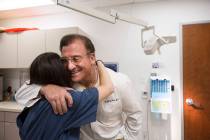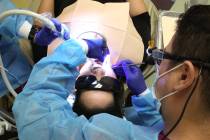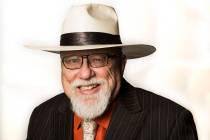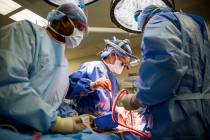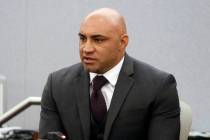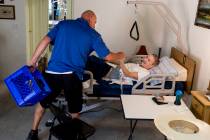America’s big, fat, bleakdreading
As she finished the hot dog and Baby Ruth bar she was eating inside the convenience store, the rotund young mother made breakfast for her two little ones.
First, she filled a baby bottle with part of the 44-ounce cola fountain drink she purchased and gave it to the crying, chunky boy in her arms. Then two of the four sticky chocolate doughnuts she bought were handed over to the sniffling toddler with an outsized belly standing at her side.
The children quieted down as they drank and ate their first meal of the day.
“My kids love breakfast,” the mother said, laughing as she and her boys went out to her car parked at a gasoline pump.
She carried an empty paper cup, apparently so her older child would have something to drink soda from when he was through with his last two doughnuts. Mommy also had bags of potato chips and pretzels and boxes of M&M’s and pudding cups with her, no doubt so she and her boys would have something more to munch on once they hit the road.
A recent snapshot of America, 2014. Other customers in the store, including myself, shook our heads at what we saw — it’s hard not to think of it as child abuse — and then we went about our business in a country with a social system based on the principle of individual rights.
Given that a study earlier this month showed childhood obesity rates increasing during the past 14 years — rates for youths age 2 to 19 have increased from 14.5 percent to 17.3 percent — I have thought a lot about that convenience store scene.
Because if that snapshot was an indication of the children’s big picture, they’re not only virtually assured of a future of serious dental problems but also of the early onset of obesity-related illnesses, which can include diabetes, high blood pressure, heart and kidney disease, stroke, and cancers that strike from the esophagus to the colon.
I talked to several people — including medical practitioners, journalists and businesspeople — to see whether anyone would have dealt with the situation differently than what I and other customers did at the convenience store.
Even a schoolteacher-true believer in the African proverb, “It takes a village to raise a child,” doubted that a minute’s worth of advice could accomplish anything positive, but it could result in a slapped face or worse.
Virtually everyone, it seems, agrees with Dr. Muriel DeSimone, a pediatrician with HealthCare Partners, who wants a far more concerted public health campaign in schools and communities across the country, one that continually drives home the point about healthful eating and exercise so scenes similar to what I witnessed are history.
That, she realizes, is easier said than done: “We need an action plan.”
So many things in the country, she noted, are working against good health for children.
Processed, fattening foods at fast-food joints are less time consuming and less costly for parents to order up than fruits and vegetables and lean meats, the doctor acknowledged.
“And kids are doing so much more sitting down, whether it’s Facebook and Twitter or other social media, playing video games, using the computer or watching TV,” she said. “I’m always telling parents and their children when they come to me that they need to eat tons of fruits and vegetables and join sports and get off the couch … what we’re really talking about is a simple lack of exercise versus caloric intake.”
There should be, she said, no frequent visits to fast food eateries, “no screen time” during the week, “not TV, iPhone or video. … The focus should be on school and healthy activities.”
Her own two children, the doctor stressed, can watch two hours of TV on weekend days.
Parents, the good doctor said, have to learn to “say no. … I know that’s not easy. But they have to step it up when it comes to the health of their kids.”
Though I agree with DeSimone, it’s doubtful American parents can “step it up when it comes to the health of their kids” anytime soon. Not when studies show a third of them are obese and 70 percent are overweight. The “do as I say, not as I do argument” seldom works for long.
(While obesity in children is defined by the Centers for Disease Control and Prevention as where an individual falls on age and sex specific growth charts, the CDC defines obesity in adults as having a BMI or body mass index — a ratio of weight to height — above 30. An adult with a BMI between 25 and 29.9 is considered overweight.)
Jeffrey Keleman, the owner of Everything Medical, the largest medical supply store in Las Vegas, said that when manufacturers of medical supplies look to the future, they can see the biggest profits coming from products for the overweight and obese for decades to come— “it’s definitely a generational thing.”
“It’s the growth area of the medical supply business,” he said. “No one sees it contracting.”
So if the bariatric manufacturers are correct, the progeny of today’s Big Daddy and Big Mama will transform an industry.
Braces for joints that crumble under excess weight will be made even stronger. So will scooters and walkers that give heavyweights mobility. The 4X diapers worn to deal with the incontinence so often caused by obesity will have greater waterproofing. The Big John Toilet Seat will be made even wider.
I was at Keleman’s store on West Charleston Boulevard as a father and son admired a newer version of a chair Dad already had at home. It is already so powerful it can push a 500 pounder to his feet with no strain.
“When you’re ready for one,” the father joked with his son, “it’ll have the thrust of a Dodge Charger with a Hemi engine.”
Contact reporter Paul Harasim at pharasim@reviewjournal.com or 702-387-2908.








